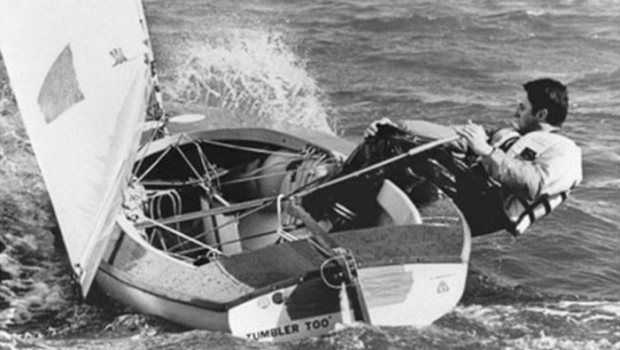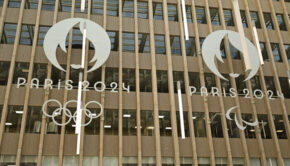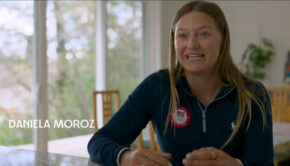Olympic Sailing: How we got here
Published on November 22nd, 2022
Longtime Canadian coach Mark Lammens takes us down memory lane on how the Olympic Sailing Program has evolved:
When I was first attracted to Olympic sailing, all the boats were designed for big men. The top sailors were larger than life. They won big silver World Championship trophies and Olympic medals. Some wrote great books and others made fast sails and built fast boats.
Some top sailors were secretive and mysterious representing nations behind the iron curtain such as DDR/East Germany and SR/Soviet Union. They were not always at major events and they never traveled away from Europe, but when they sailed at the Olympics they were almost always in the medals.
This group included 3-time gold and 1-time silver medalist Jochen Schumann, (born in East Berlin) and 3-time gold and 1-time silver medalist Valintin Mankin (born in the Ukraine). Also Andrey Balashov and Viktor Potapov.
When the Soviet Union dissolved before the 1992 Olympics, countries like Ukraine, Estonia, Latvia, Lithuania, and Belarus were added to the participating sailing countries. Ukraine, Estonia and Lithuania have gone on to win sailing medals.
At the same time East Germany rejoined West Germany making qualification very difficult. Two of Schumann’s medals were earned when he was sailing for united Germany.
In 1972, the Olympic boats were a displacement dinghy, the Finn, and keelboats (Dragon, Star, Tempest, Soling) and the high performance Flying Dutchman. The Olympics brought the different cultures, nations, ideologies, and languages together every four years to share sport.
However, the boats used in sailing did not promote inclusiveness; they were too big for smaller men and women. Olympic sailing classes claimed to be “open” but really they were not. The women’s marathon was added to the Olympic event list before there was a women’s sailing event.
In 1988, women’s sailing was finally added to the Olympic sports list with the 470. In 1992, two additional women’s events were added – Europe and Windsurfer. In 2004, the keelboat Yngling class was included for women. In 2016, the 49erFX replaced the women’s keelboat.
Now, Olympic Keelboats have been dropped from the schedule to reduce cost and highlight athleticism. Class specific fitness for each boat is with pumping, hiking, and trapezing skills to keep dinghies upright and fast. Costs for potential hosts are reduced by not requiring cranes and docks at sailing venues, and athletes can sail less expensive boats.
Sailing was successful with participation at the Paralympics. Sailors with disabilities raced in 1996 when Sailing was a demonstration sport at the Paralympic Games. From 2000 to 2016, Sailing was added to the Paralympic sport list, but lost status due to low international participation. Participation numbers have improved but reinstatement of the sport has not been successful to date. The expense of keelboats, cranes, and docks may also be contributing factors.
A mixed boat (1 male, 1 female) was added to the schedule in 2016 with the Nacra 17. The mixed 470 and the new Kite class for men and women will be added in 2024. This means women will have the same opportunity as men to excel at the highest level at the Paris, 2024 Olympics.
Racing formats and rules evolved over time. Today, there are 11 or 16 shorter races, simpler race scoring, and alternative ‘on the water’ penalties.
The singlehanded Finn class has been in 18 Olympics starting in 1952 but was dropped after Tokyo 2020. Paul Elvstrom and Ben Ainslie both won three Olympic Gold medals in the Finn and Gilles Scott won two. It is the boat past International Olympic Committee President Jacques Rogge sailed.
The first Finns were wood, with wooden masts and cotton sails. There were no rules on how much weight sailors could wear when the wind was strong. Today, the boat has a lower weight, carbon wing masts and plastic sails. The Finn has measurement rules with minimum weights and parameters that allow for slight variations and opportunities to adjust performance variables. In other words, there could be slightly different boats, masts and sails.
The Laser is the original ‘One Design’ singlehanded dinghy. It has the largest international representative fleet with high quality and depth that cannot be ignored. The Laser has been heavily influenced by the Finn.
The Laser’s one design manufactured provided simplicity concept was what Paul Elvstrom promoted in his books. The Laser was designed by Bruce Kirby, who raced Finn and finished 8th at the Olympics. The first molds and boats were built by Ian Bruce who also sailed Finn and finished 7th at the Olympics. The mast, sail and rig developer was Hans Fogh, who finished 2nd at the Finn Gold Cup.
Unfortunately for the Finn, there was not a women’s ‘equivalent’. The Laser/ILCA 7 for men and Radial/ILCA 6 for women meets the Olympic gender balance requirement which led to the equipment no longer having an event to fill.
Sailing Program for the Paris 2024 Olympics:
Men’s One Person Dinghy – ILCA 7
Women’s One Person Dinghy – ILCA 6
Mixed Two Person Dinghy – 470
Men’s Skiff – 49er
Women’s Skiff – 49erFX
Men’s Kiteboard – Formula Kite Class
Women’s Kiteboard – Formula Kite Class
Men’s Windsurfing – iQFoil
Women’s Windsurfing – iQFoil
Mixed Multihull – Nacra 17









 We’ll keep your information safe.
We’ll keep your information safe.